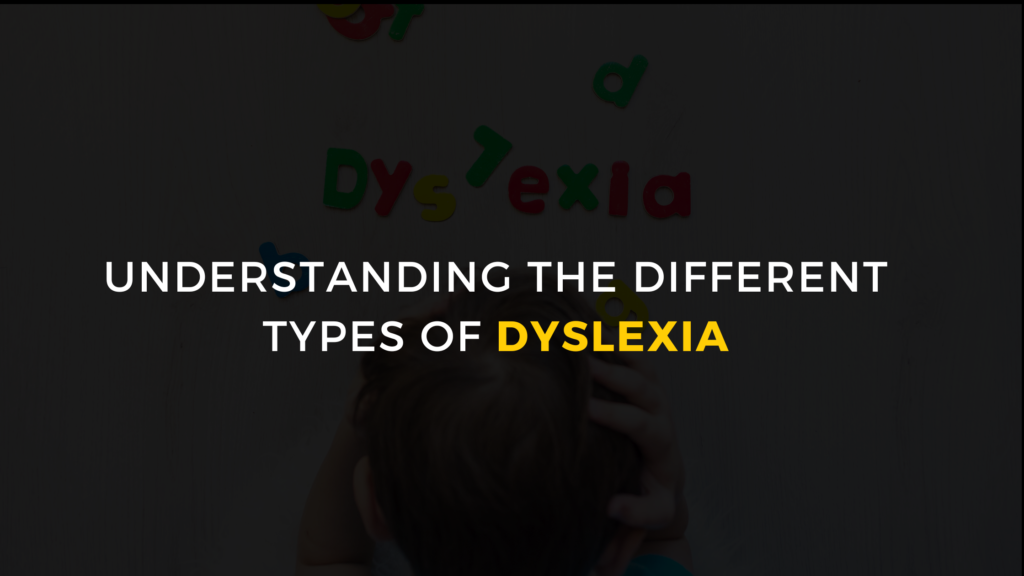If your child has problems reading, sounding out words, or understanding what they have read, they may have dyslexia.Dyslexia can be developmental (genetic) or acquired (arising from a disease or traumatic brain injury). There are also other type of dyslexia including phonological dyslexia, quick naming dyslexia, double deficit dyslexia, surface dyslexia, and visual dyslexia are a few of the numerous types of dyslexia. This is a description of each form of dyslexia’s symptoms and difficulties.
Between five and twenty percent of the population, according to estimates of the prevalence of dyslexia, have difficulties reading. It’s crucial to be able to recognize the issue early and be aware that there are different varieties of dyslexia in order to come up with the best teaching tactics.
Dyslexia training program from I Empower, LLC can assist you if you’re looking for the answer to the question “how to identify dyslexia?”

What Is Dyslexia?
Dyslexia is a type of learning disability that affects a person’s spelling, writing, and comprehension skills, which in turn affects their ability to read. Dyslexia is a learning disability that a child cannot overcome, so it is crucial to get a diagnosis and start using remediation methods as soon as feasible. Dyslexia can be diagnosed in anyone, even if the adult dyslexia test technique is different from the adult dyslexia test procedure. Although people with dyslexia are typically incredibly intelligent and creative, many struggle with basic reading skills.
Dyslexia symptoms include:
- Delayed speech development
- Difficulty learning new words
- Grammar issues
- Reading below the age-appropriate level
- Difficulty with rhyming words
- Confusing letters for each other
- Having difficulty copying words from a secondary source
- Poor sentence structure
- Lack of phonemic awareness
- Problems spelling
- Avoidance of reading aloud
Additionally, there are subtle behavioralsigns to look out for in kids with dyslexia, such as:
- Withdrawal from peers
- Misbehavior or acting out
- Depression
- Appearing unmotivated or lazy
- Peer and sibling relationship difficulties
- Self-esteem issues
- Loss of interest in school
Recognizing early symptoms of dyslexia symptoms can aid in a quicker diagnosis, offering a greater chance for improvement overall.
What Are the Types of Dyslexia?
To better the success of treatment, scientists have categorized a variety of prominent kinds of dyslexia. In order to provide the best support, educators can design techniques that are specific to the needs of the child by understanding the many varieties of dyslexia.
Phonological Dyslexia
This specific type of dyslexia is frequently the first to spring to mind when the term is used. The difficulties of deciphering language sounds and matching sounds to symbols are addressed. People with phonological dyslexia have trouble understanding or sounding out words. It is phonological dyslexia that is regarded to be the most common type of dyslexia. the following signs of phonological dyslexia:
- Difficulty learning sounds made by letters or letter combinations
- Difficulty sounding out unfamiliar words
- On the same page, spelling the same word differently
- Difficulty spelling
- In new contexts, difficulty recognizing familiar words
- Slow reading
- Avoiding reading activities
Rapid Naming Dyslexia
Rapid naming dyslexia may be present in those who find it difficult to quickly nameletters, colors, and numbers when they are presented with them. Reading speed and reading processing speed may both be affected by this kind of dyslexia. Individuals with rapid naming dyslexia can nameletters,colors, and numbers, but it frequently takes them a lot longer to think of the right word. Rapid naming dyslexia may cause the following symptoms:
- Difficulty retrieving words
- Slow to respond orally
- Using gestures in place of words
- Often leaving words out altogether or substituting words
- Slower to complete writing or reading assignments
- Making up meaningless words in place of real words
Double Deficit Dyslexia
For someone with double deficit dyslexia, two aspects of reading are challenging. Two of these two aspects that are usually addressed are the ability to recognize word sounds and naming speed. Despite being very uncommon, this form of dyslexia, which combines rapid naming and phonological processing, is often regarded as the most severe. Signs of double deficit dyslexia include the following:
- When asked to recall words, poor naming speed rate
- Weak phonological awareness
Surface Dyslexia
Someone who finds it simple to sound out new words but finds it difficult to quickly recognize well-known ones may have surface dyslexia. In this case, experts argue that the brain in this circumstance fails to understand how a word appears since it is trying to process words quickly. Because they don’t sound like their spellings, words that need to be memorized are harder to sound out when you have this type of dyslexia. Surface dyslexia is sometimes known as visual dyslexia or dyseidetic dyslexia. It is common for a dyslexic person to experience both phonological and surface dyslexia. Some indications of surface dyslexia include:
- Difficulty with whole word recognition
- Avoidant of reading activities
- Slow to read
- Difficulty with spelling
- Difficulty reading new words by sight
- Having difficulty to read words that don’t sound the way they’re spelled
Visual Dyslexia
If a child has problems remembering what they have read on a page, they may have visual dyslexia. This kind obstructs the processing of visual information, preventing the brain from acquiring an accurate depiction of what the eyes see. Visual dyslexia will have an influence on learning to spell or form letters because both require the brain to remember the correct letter sequence or shape, which interferes with learning. These are symptoms of visual dyslexia:
- Textgoing in and out of focus or appearing blurred
- Text appearing double or swapping between double and single
- Difficulty tracking across lines of text
- Difficulty keeping place in text
- Headaches and/or eyestrain associated with reading
Categories of Dyslexia :
Developmental Dyslexia
Dyslexia that is genetically predisposed or present at birth is referred to as developmental dyslexia. Both primary and secondary dyslexia are categorized as developmental dyslexia. Boys are more likely than girls to have this kind of dyslexia, and it usually gets better as kids get older.
Primary Dyslexia
It is referred to as primary dyslexia if the disorder that causes the dyslexia is genetically inherited. The likelihood that a child will have dyslexia increases if both parents do. It’s interesting to note that guys, especially left-handed ones, are more likely to have primary dyslexia and that it may run in families.
Secondary Dyslexia
Early pregnancy-related issues with brain development can lead to secondary dyslexia. Due to the fact that both primary and secondary dyslexia start at birth, both conditions are developmental.
Acquired Dyslexia
Dyslexia can occasionally emerge when a sickness or traumatic brain injury damages the brain’s language processing regions. Because it is the only kind of dyslexia with a known cause and is brought on by trauma to the brain, this kind of dyslexia is also known as trauma dyslexia.
Other Learning Difficulties Associated with Dyslexia
A person with dyslexia may also suffer a number of other learning challenges more frequently. In contrast to certain forms of dyslexia, they are neurological disorders, according to doctors. These learning challenges consist of:
- Left-right disorder. Directional dyslexia is the term used to describe the inability to distinguish between left and right.
- Dysgraphia. Word spacing, size, spelling, legibility, and expressiveness are all impacted when people struggle with writing and other fine motor abilities.
- Dyscalculia. a limitation on one’s capacity for precise math computations, problem-solving and reasoning, understanding concepts relating to numbers, and mastering fundamental math abilities. Numeral or math dyslexia are other names for dyscalculia.
- Auditory processing disorder. Those who have auditory processing disorders have difficulty processing different speech sounds in their brains. Auditory dyslexia is another name for this disease.
Can Trauma Cause Dyslexia?
Certainly, it has been suggested that trauma, both physical and emotional, may contribute to the development of dyslexia.
Traumatic dyslexia, also known as acquired dyslexia, can appear after a person has sustained a traumatic brain injury (TBI), which can be caused by accidents involving a vehicle, falls from ladders, sports injuries, etc. Trauma dyslexia may develop as a result of a stroke or concussion. Trauma dyslexia can impact anyone, but it tends to affect adults more than children.
On the other hand, emotional trauma can also contribute to dyslexia. It is stated that early exposure to stressful situations, such as neglect,emotional abuse, bullying, environmental disaster,witnessing disaster or death, etc., may result in dyslexia and other learning issues even though there is little study on this sort of dyslexia.
Can You Outgrow Dyslexia?
Dyslexia cannot be outgrown and does not go away, but the difficulties that come with it can be greatly reduced with early intervention, the right teaching, and support.In addition to early intervention and support, there are a number of assistive technologies, such text-to-speech, that can aid individuals with dyslexia.Even though dyslexia never fully “goes away,” most people can adapt to and overcome the challenges it presents.
What Does a Dyslexic Person See?
Every dyslexic person is unique, and what they perceive will depend not just on the type of dyslexia they have but also on how severe it is. One person might perceive numbers and letters upside down or backwards, while another person might not be able to tell the difference between letters like e, c, and o. Other times, letters could show up jumbled and out of sequence, or they might be grouped together. In truth, some dyslexic persons can read without much difficulty, although they may find it difficult to sound out words and connect the letters.
When it comes to what a dyslexic person experiences or struggles with, there is no universal solution. The only way to be certain is to have a professional diagnosis, during which the doctor may carry out various tests like word recognition, reading fluency and comprehension, decoding, spoken language skills, and more.
Does Dyslexia Only Affect Reading Skills, or Does It Also Affect Speech?
Indeed, dyslexia can impair one’s capacity for speaking as well as reading. In fact, delayed speech development in children is one of the early indicators of dyslexia. Children with dyslexia may experience a variety of speech problems in addition to this delay, including stuttering or speech insufficiency, decreased phonological awareness, diminished phonological recall, jumbling up similar-sounding words, and poor phonological awareness.
A child’s ability to speak can be less negatively impacted by dyslexia by participating in speech therapy under the supervision of a certified Speech-Language Pathologist. SLPs can support early language development and assist in evaluating a child’s reading and writing skills.
Can You Develop Dyslexia Later in Life?
The majority of dyslexics are born with the condition, but dyslexia can also appear later in life. As mentioned above, traumatic brain damage, such as a stroke or concussion, is the most common cause of this late-onset condition. On the other hand, it’s more possible that you’ve had dyslexia all your life and it wasn’t discovered until much later if you were only diagnosed as an adult and haven’t had a traumatic brain injury.
What to Do If You Suspect Dyslexia
Talking about your concerns with your primary care physician should be your first step. Developmental delays, behavioral problems, or mental health issuescan all be causes for concern. Ask your child’s teacher about their academic performance, social interactions, and any difficulties the staff may have noticed. To confirm a dyslexia diagnosis, ask for additional testing, either through your family doctor or your child’s school.
AtI Empower, LLC, it is our vision thateach parent, teacher, and student is aware of the signs of dyslexia and the appropriate interventions and modifications required to enable individuals affected lead lives where they feel confident and empowered. You can sign up for the dyslexia training program for teachers or parents to acquire knowledge of the lookouts for dyslexia.
